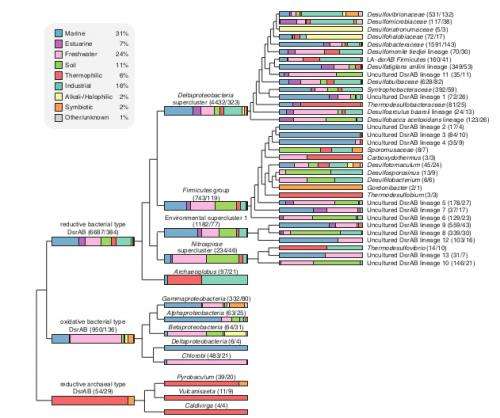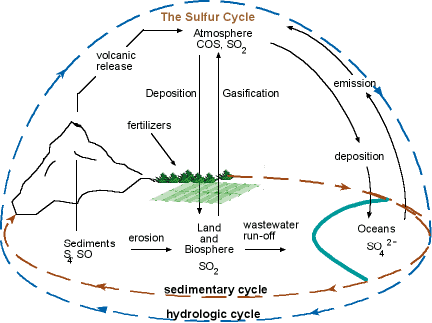Environmental distribution of dsrAB diversity. This figure from Muller et al (2014) shows the classification of 7695 dsrAB sequences. A wealth of microorganisms play a role in the cycle of sulfur on Earth, a process that is important in maintaining the habitability of Earth. Credit: Müller et al. (2014)
Scientists have a constructed a new database of the diversity in an enzyme that is used by microorganisms to metabolize sulfur.
Specifically, the study centers around an enzyme call Dsr-AB-type dissimilatory bi(sulfite) reductase. Basically, this enzyme is used to kick-start reactions in cells that convert sulfur from one form to another. These conversions are important steps in the global sulfur cycle on Earth.
The type of enzyme in question is used in many environments on Earth by different microorganisms, and scientists use these enzymes as a marker for studying populations. The new database could help scientists draw comparisons in sulfur metabolism across different populations of microorganisms in a variety of habitats. The new tool will shed light on the evolutionary history of these enzymes and their place in Earth's the biosphere.
Already, the researchers have identified at least thirteen different lineages for sulfite/sulfate-reducing microorganisms that have not yet been cultured in the laboratory. This means that members of some of the major groups of organisms that use these enzymes have yet to be identified.
Studying the role of microbial metabolism in cycling elements necessary for life on Earth is important for astrobiologists studying habitability on other worlds. Biogeochemical cycles are necessary for maintaining habitats for life on planets, and studying them can help determine how microbes might be responsible for global biosignatures that would help us detect alien life – such as the composition of elements in a planet's atmosphere.
A general diagram of the biogeochemical cycling of sulfur on Earth. Credit: Carnegie Mellon
Organisms that cycle sulfur are also important in extreme habitats on Earth, such as the deep subsurface of our planet. Studying the intricacies of chemical reactions inside microscopic organisms may seem like it's a long way from space science, but these studies can help astrobiologists understand the mechanisms that life might use to survive on worlds where environmental conditions are much more extreme than the Earth.
Source: Astrobio.net
This story is republished courtesy of NASA's Astrobiology Magazine. Explore the Earth and beyond at www.astrobio.net .

























